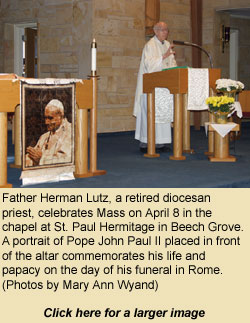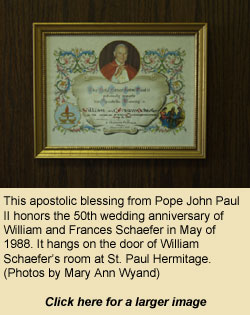St. Paul Hermitage residents reflect
on pope's life and witness
By Mary Ann Wyand
 BEECH GROVE—Pope John Paul II’s witness of the spiritual value of redemptive suffering as his health continued to decline in recent years was a powerful inspiration for many residents of St. Paul Hermitage, which is operated by the Sisters of St. Benedict of Our Lady of Grace Monastery.
BEECH GROVE—Pope John Paul II’s witness of the spiritual value of redemptive suffering as his health continued to decline in recent years was a powerful inspiration for many residents of St. Paul Hermitage, which is operated by the Sisters of St. Benedict of Our Lady of Grace Monastery.
Father Herman Lutz, a retired diocesan priest who resides at St. Paul Hermitage, said on April 8 that “the Holy Father was a wonderful example, in the beautiful spirit that was his and the beautiful optimism and his deep faith, especially in his later years as his health began to wane or to falter.
“He didn’t let that stop him,” Father Lutz said. “He continued to serve the Lord as best as he could. He continued to travel. He literally wore himself out right up to his death doing the work of the Lord. It’s a beautiful example, I think, for older people. It shows older people that they can still do something good with their lives. He was an example to all of us. He was a wonderful pope.”
Father Lutz said the Holy Father’s last prayer response—“Amen”—before his death was especially fitting.
“The word ‘Amen’ means ‘so be it,’” Father Lutz said. “It’s almost like the last words of Jesus—‘It is finished.’ … It was a beautiful way to end his life.”
Msgr. Richard T. Kavanagh, who at age 93 is the oldest diocesan priest, served the archdiocese for 69 years. He retired in 1982 at age 70 and moved to St. Paul Hermitage seven years ago.
“When the pope died, I lost one distinction,” Msgr. Kavanagh said. “I was nine years older than the pope.
“Of course, he was an example to all of us not to quit too early,” Msgr. Kavanagh said. “He was an encouragement to keep going. I was hoping that he wouldn’t suffer too much. I was pretty sure he was in bad shape. I think he gave us a good example of how to face death because that’s not an easy thought, particularly at my age, but he did show that you don’t really fear death, you fear what leads up to it.”
 Msgr. Kavanagh said there are only two priests in the diocese who have lived during the papacies of eight popes, beginning with Pope Pius X, who died in 1914. Father Louis Marchino, who is spending his retirement years in New Albany, is the second oldest priest in the diocese and can also claim that distinction.
Msgr. Kavanagh said there are only two priests in the diocese who have lived during the papacies of eight popes, beginning with Pope Pius X, who died in 1914. Father Louis Marchino, who is spending his retirement years in New Albany, is the second oldest priest in the diocese and can also claim that distinction.
Msgr. Kavanagh recalled that when Cardinal Karol Wojtyla of Poland was elected pope in October 1978, “I thought that definitely was a sign that the Holy Spirit was active because he was the most unlikely person I would have expected. Of course, he’s been an inspiration all the way along with his enthusiasm and his willingness to meet other people and get along with them.
“The only time that I ever saw him, by the way, in person, was when I was part of the Indianapolis delegation when he came to Chicago in October 1979,” Msgr. Kavanagh said. “That was the only time that I came into real contact with him. It was a wonderful celebration. There was a big crowd at Grant Park.”
Msgr. Kavanagh said he also saw Pope John XXIII in Rome in 1961 and was standing two feet away from him during a papal audience at the Vatican.
Msgr. Kavanagh said he woke up at 3 a.m. on April 8 to watch the live broadcast of the papal funeral.
“I thought the funeral was wonderful,” he said. “I thought it was worthwhile losing some sleep over. After all the trouble the Church has had lately, that was, I think, a big boost for all of us.”
Msgr. Kavanagh said Cardinal Joseph Ratzinger, dean of the College of Cardinals and the principal celebrant during the papal funeral liturgy, is his choice for the next pope.
“He’s a very smart fellow,” Msgr. Kavanagh said, “but I doubt that they will follow my choice. The successor will have a lot of problems. No question about it. They’ll try to take advantage of the new man. But he’s not going to make many changes. There are certain things that you can’t change—doctrine, for one thing. But I don’t think the new pope is going to travel as much as Pope John Paul did.”
Alice Olinger, who has lived at the hermitage for a year, said she admired Pope John Paul II and thinks his life story and remarkable papacy qualify him to be a saint.
“He was firm on the issues like abortion,” Olinger said. “He told you as a Christian how you should live.”
William Schaefer, a retired teacher who is 91 and has lived at St. Paul Hermitage for seven years, said Pope John Paul II was an inspiration because “he stood up for what he thought.”
Schaefer has a framed print of a 50th anniversary blessing from the Holy Father hanging on his door at the hermitage.
The pope’s last days were “miraculous, really,” Schaefer said, “from the shape that he was in.”
Schaefer said he was with a group of about 20 Catholics who attended a papal audience with Pope Paul VI at the Vatican in 1975.
“We probably will get an Italian pope again,” Schaefer said. “I’m sure people will urge him to travel like Pope John Paul did.”
Josephine Donohue, who moved to the hermitage last August, said she worked as a cook at the former Bishop Bruté Latin School in Indianapolis from 1967 until it closed 18 years later.
“I just think it’s wonderful that he worked with the young people,” Donohue said of the pope. “That’s what we need in the Church—for the young to take over for us because we’re getting too old. I think the way he suffered at the end was admirable because it does teach people that you have to take the bad with the good.”
Donohue said she watched the live broadcast of the papal funeral and was especially touched by “the devotion that the people had for him.” †

